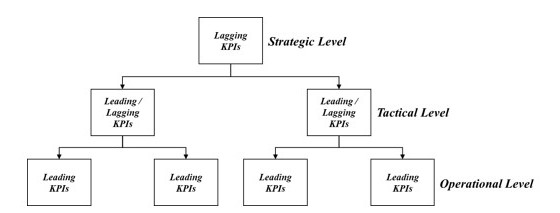Integration of Leading and Lagging Indicators in Healthcare for Quality Improvement
Vijayakrishnan Poondi Srinivasan, MS, LSSBB
Quality Management Engineer
Maine Medical Center
Learning Objectives:
- Introduction to Performance Measurement System (PMS) and Hierarchical Levels
- Alignment of Leading and Lagging Indicators in the PMS
- Illustrate integration of Leading and Lagging Indicators in Healthcare for Quality Improvement
An effective Performance Measurement System (PMS) enables an organization to assess whether goals are being achieved and facilitates improvement by clarifying goals, highlighting gaps, and facilitating reliable forecasts. Therefore, a strong PMS enables an organization to align its process level performance with management level goals.
A comprehensive PMS is constructed at three levels based on the hierarchy of the organization:
- Strategic Level: The main objective of this level is to translate the needs of the customer and stakeholder into defined goals and objectives.
- Tactical Level: This level supports the strategic goals and objectives developed in the strategic level and defines the drivers for achieving those goals.
- Operational Level: This level regulates the day-to-day output relative to schedules, specifications, and other aspects. The main scope at this level is streamlined process to work as quickly and efficiently as possible.
The PMS is characterized by the mixture of two types of performance measures. They are leading (cause) and lagging (effect) indicators respectively. The leading indicators are performance drivers in the operational level. Also, leading indicators are the operational inputs to the process. The lagging indicators are core outcomes that have a serious impact on the strategic level of the PMS. A balanced PMS should have a mix of outcome measures (lagging indicators) and performance drivers (leading indicators) which yield a cause-and-effect relationship.
Leading Indicators are also termed Performance Indicators (PI) and are present at the operational level and tactical level of the system. PI are the fundamental set of indicators defined for a process. These indicators include the input provided for each process. Strategies formulated at the management level are applied to PI because they serve as the input to the system.
Lagging Indicators are termed Key Performance Indicators (KPI) and are present at the strategic level and tactical level of the system. KPI are derived from the fundamental performance measures of a process. They are very useful to collect information on day-to-day activities and progress of a process. These indicators guide strategies for achieving the objective of an organization. The frequency of measurement differs based on the nature of the indicator, but they are often collected on a daily basis. It is important to establish a cause-and-effect relationship by linking the performance measures (PI and KPI) within and between different levels of the performance measurement system.

Figure 1: Alignment of Leading & Lagging Indicators
The application of this concept in Healthcare provides clarity in tracking the performance of the system at various levels of the organization. The example provided below, from the Orthopedics Service Line Clinical Transformation Project, demonstrates how efforts made in the operational level flow into the tactical level, and ultimately impact the strategic goals of the organization.
Problem Statement: Until January of 2018, Centers for Medicare & Medicaid Services (CMS) had Total Knee Replacement (TKR) on the inpatient procedure only list. This requirement changed and CMS expected institutions to classify TKR patients as inpatient or outpatient and support this with appropriate documentation.
Goal: To have same day or one (1) overnight length of stay (LOS), making the procedure truly outpatient with respect to level of care.
Strategic Level Measures:
- Reduce average LOS ≤ 1.3 days
- Reduce reoperation rate (90 days)
- Reduce readmission rate (90 days)
- Reduce post-operative ED Visit rate (90 days)
- Maintain or improve patient satisfaction scores
- Reduce the variable direct cost per case for the episode of care by “X%”
Tactical Level Measures:
- Increase % of patients receiving Tranexamic Acid (TXA)
- Increase % of patients receiving Spinal Anesthesia
Operational Level Measures:
- Implement patient inclusion and exclusion criteria for one-day knee replacement procedure
- Develop and implement a clinical pathway for patients eligible for one-day knee replacement surgery
- Educate patients on the entire episode of care to prepare them for surgery and avoid any delays with on-time discharge
- Increase the % of patients attend the educational session prior to surgery
References:
- Daniels RC, Burns N. A framework for proactive performance measurement system introduction. International Journal of Operations & Production Management. 1997.
- Bourne M, Mills J, Wilcox M, Neely A, Platts K. Designing, implementing and updating performance measurement systems. International journal of operations & production management. 2000.
- Kueng P. Process performance measurement system: a tool to support process based organizations. Total quality management. 2000.
- Rodriguez RR, Saiz JJA, Bas AO. Quantitative relationships between key performance indicators for supporting decision-making processes. Computers in Industry. 2009.
5. Tangen S. Performance measurement: from philosophy to practice. International journal of productivity and performance management. 2004.
Want to earn CE Credits? Click here
